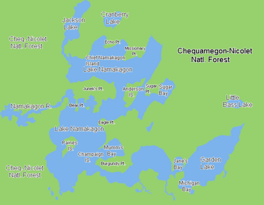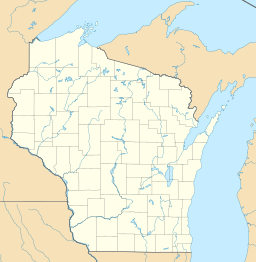Lake Namakagon facts for kids
Quick facts for kids Lake Namakagon |
|
|---|---|
 |
|
| Location | Bayfield County, Wisconsin near Cable, Wisconsin |
| Coordinates | 46°12′57″N 91°06′40″W / 46.2157°N 91.111°W |
| Type | Glacial lake |
| Primary inflows | Namakagon River |
| Basin countries | United States |
| Max. length | 43.670 (70.280 km) |
| Average depth | 38.000 ft (11.582 m) |
| Max. depth | 51.000 ft (15.545 m) |
| Water volume | 52,032 acre-feet (64.181×106 m3) |
| Shore length1 | 43.670 mi (70.280 km) |
| Islands | Paines Island, Anderson Island |
| Settlements | Namakagon, Wisconsin |
| 1 Shore length is not a well-defined measure. | |
Lake Namakagon (say it: NAM-uh-KAH-gun) is a large freshwater lake in Bayfield County, Wisconsin. It's connected to streams that flow between Lake Superior and the Mississippi River. The lake's name comes from the Ojibwe language. It means "Lake abundant with sturgeons". People love to visit Lake Namakagon. It's also known as the home of a famous Anishinaabe leader, Chief Namakagon.
Contents
Lake Namakagon's History
The area around Lake Namakagon was once covered by thick forests. From the late 1800s to the 1920s, many trees were cut down for timber. This was a big business after the American Civil War. A railroad arrived in 1880, bringing both timber and early tourists to the area. The forests here have many different kinds of trees, including pine and white spruce.
The Legend of Chief Namakagon
From the 1830s to 1886, a Native American leader lived by the lake. He was known as Chief Namakagon. He became famous because of stories in the Ashland Daily Press newspaper. These stories said he traded pieces of silver for supplies. No one ever found out where he got the silver, and people still look for it today!
Today, tourism is the main business around the lake, not logging. The Namekagon River also starts from this lake.
About the Lake's Features
Lake Namakagon covers about 2,897 acres. Its shoreline is about 43.67 miles (70 kilometers) long. The deepest part of the lake is 51 feet (17 yards) deep. The average depth is about 16 feet (5.3 yards).
The lake holds a lot of water, about 52,032 acre-feet. A dam was built on the west side of the lake in 1926. This dam helps control the water level. Lake Namakagon was formed by glaciers long ago. The bottom of the lake is mostly sand and muck. The water in Lake Namakagon is not very clear.
Plants and Animals in Lake Namakagon
Lake Namakagon is a great place for fishing! It's home to many types of fish. You can find muskellunge, bluegill, sunfish, largemouth and smallmouth bass, crappie, northern pike, and walleye. The lake is known as a "trophy muskie lake." This means it's one of the best places in Wisconsin to catch very large muskellunge.
The lake is considered a "eutrophic" lake. This means it has a lot of nutrients, which can lead to lots of plant growth.
Fun Things to Do at Lake Namakagon
Lake Namakagon offers many fun activities for visitors. You can go camping, hiking, and biking on the trails. There are also water activities like kayaking, jet skiing, swimming, and boating. You can even try tubing, waterskiing, and windsurfing!
Camping and Trails
The campgrounds around the lake have places for parking, picnic tables, and fire rings. You can get fresh water and use vault toilets. The campgrounds are surrounded by beautiful forests.
Near the campgrounds, you'll find several trails:
- The North Country National Scenic Trail
- The CAMBA Mountain Bike Trails
- The Rock Lake National Recreation Trail
There's also a one-mile loop called the Namekagon Trail. It's great for beginners!
Day-Use Areas
If you're just visiting for the day, there are special areas open to the public. These spots have shelters, picnic tables, and grills for cooking. They are perfect for enjoying the outdoors.
Places to Visit and Stay
Lake Namakagon has several restaurants and resorts. Many of the resorts offer cabins and lodging with views of the lake. They have a cozy "Northwoods" style.
Some of the resorts include:
- Lakewoods Resort & Lodge
- Mogasheen Resort
- Garmisch USA Resort
- Westwind Resort
- Four Seasons Resort
- Mortenson's Resort
The lake also has a few islands, like Paines Island and Anderson Island.
Protecting Lake Namakagon
There are some important things people are doing to keep Lake Namakagon healthy.
Invasive Species
Invasive species are plants or animals that are not native to an area. They can cause problems by taking over the lake and harming native species. Some invasive species found here are:
- Hybrid Eurasian watermilfoil
- Purple loosestrife
- Chinese mystery snail
- Curly leaf pondweed
These invaders can block sunlight for native plants or change habitats. To help control them, people are educating lake users and checking boats for invaders.
Water Quality
The water clarity in Lake Namakagon has been low. Volunteers help by collecting water samples. They use a special tool called a "secchi disk" to measure how clear the water is. Clearer water means a healthier lake.
Protecting Habitats
It's important to keep trees and stumps in the lake. These "woody covers" provide homes for fish and other wildlife. Also, controlling erosion (when soil washes away) helps protect the shoreline and fish spawning areas. Planting more vegetation along the shore helps prevent soil from washing into the lake.
Lake Management
Good management practices are needed to keep the lake clean. This means working to reduce trash, dirt, and extra nutrients from getting into the lake system. The Wisconsin's Forestry Best Management Practice for Water Quality helps guide these efforts.
Images for kids
-
Lythrum salicaria (Purple loosestrife)
-
Cipangopaludina chinensis (Chinese mystery snail)






